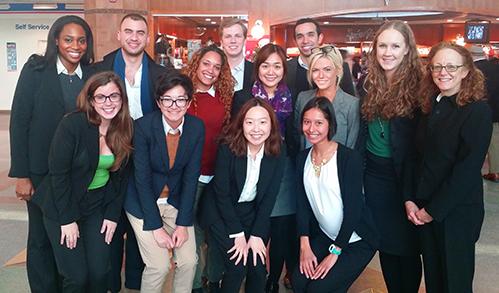Advocating in Albany
Students in Columbia Law School's Adolescent Representation Clinic Traveled to Albany with Professor Jane Spinak to Advocate for Resources for Youth Aging Out of Foster Care
New York, March 10, 2015—Students enrolled in Columbia Law School’s Adolescent Representation Clinic met with lawmakers in Albany last month to advocate for more resources to support vulnerable youth who are aging out of foster care. The trip was supervised by Professor Jane M. Spinak, a renowned children’s rights advocate who created the clinic to address the legal challenges foster children and teenagers face.
Approximately 20,000 young people live in foster care in New York State each year, according to the Fostering Youth Success Alliance, which helped organize the trip on Feb. 10. Of that group, nearly one fifth is between the ages of 18 and 21 and aging out of the system. Former foster youth disproportionately end up homeless or with criminal records, and the population often struggles to enroll and succeed in college. Unlike many other states, New York does not offer tuition waivers or other services specifically to help foster youth succeed in college.
During the visit to Albany, the clinic’s students joined together with other advocates in support of a pilot a program to help an initial cohort of 375 students in their college educations.
Top row (left to right): Alana Walker '16, Vince Novelli '16, Loretta Johnson '16, Mark Cherry '16, MK Han '16, Josh Rosario '15, Caroline Turner '16, Madeleine Brumley '16, Professor Jane Spinak, Front row (left to right): Shannon Cleary '15, Ashleigh Hunt '15, Seoung Kim '16, Ashley Morales '15 |
Alongside young people in foster care speaking out for themselves and their peers, Columbia Law School students spoke about the pilot with officials such as Assembly Member Daniel J. O’Donnell and a senior staff member for New York State Senator Bill Perkins. The districts of O’Donnell and Perkins include Columbia University.
“I was pleasantly surprised that the people we met with didn't automatically say yes or no, but were really there to listen and be convinced,” said Vince Novelli ’16.
Shannon Cleary ’15, a teaching assistant for the Adolescent Representation Clinic who helped organize the trip, said it was important to tailor different messages to lawmakers, staffers, and agency personnel who play different roles in the legislative process.
“For politicians, you should talk about the extent of the problem and how your client exemplifies the problem, while providing much more specific information to people from agencies,” Cleary said.
Seoung Yeon Kim ’16 said the students had to be prepared to engage people with vastly different degrees of understanding of the problem.
“It’s important not to assume that particular staffers or legislators have any level of information on your priorities and to be ready to speak in depth or more generally,” she said.
Several students noted that actions speak louder than words, so the goal of advocacy should always be to secure specific commitments.
“You have to look for specific and measurable requests. If everyone is accountable, then no one is accountable for anything,” Madeleine Brumley ’16 said.
The students’ trip took place shortly after the arrest of Sheldon Silver, longtime speaker of the New York State Assembly, and amidst continuing controversy over the abrupt end of the Moreland Commission, which had investigated corruption in state politics. As a result, they returned thoughtful about how citizens can organize to outflank special interests in favor of the public interest.
“Corruption makes you think about what power and influence you can marshal to push for your priorities,” said Mark Cherry ’16. “Allies increase the influence you bring to the table.”
